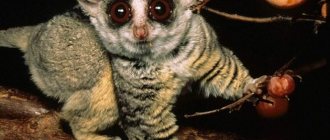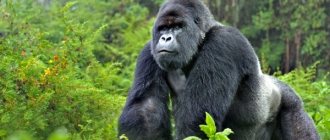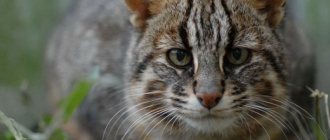Recommendations
- Groves, K. P. (2005). Wilson, D.; Reeder, D. M. (ed.). Mammal Species of the World: A Taxonomic and Geographical Guide
(3rd ed.). Baltimore: Johns Hopkins University Press. pp. 181–182. ISBN 0-801-88221-4. OCLC 62265494. - Plumptre, A.; Robbins, M.; Williamson, E.A. (2016). " Gorilla Beringay
".
IUCN Red List of Threatened Species
.
2016
: e.T39994A17964126. - "Gorillas on thin ice." UN Environment Programme. January 15, 2009. Archived from the original on May 18, 2016. Retrieved May 19, 2010: “The population of eastern lowland gorillas in the DRC has declined sharply over the past 10 years, with only about 5,000 of the 17,000 animals likely remaining.”
- “According to the latest research on mountain gorillas, there are currently at least 1,004 individuals – IUCN Red List.” IUCN Red List of Threatened Species
. July 31, 2022. July 31, 2022. - “The eastern gorilla is listed on the IUCN Red List of Threatened Species.” CBSnews
. AP. September 4, 2016. Retrieved September 4, 2016. - ^ a b
"Four of six great apes are close to extinction - IUCN Red List." September 4, 2016. Archived from the original on September 8, 2016. Retrieved September 4, 2016. - Taylor, Andrea Beth; Goldsmith, Michelle Lynn (2003). Gorilla Biology: A Multidisciplinary Approach
. Cambridge University Press. paragraph 13. ISBN 978-0-521-79281-3. - Williamson, E. and Butynsky T. (2013) Gorilla gorilla
.
In: Butynsky T. (Ed) Mammals of Africa
. Volume 6. Elsevier Press. ISBN 1408122561 - Burney, D. and Wilson, D. E. (eds.), Animals: A Comprehensive Visual Guide to the World's Wildlife
. DK for Adults (2005), ISBN 0789477645 - ^ a b
Wood, Gerald L. (1983)
Guinness Book of World Records and Animal Feats
. Sterling Pub Co Inc. ISBN 978-0-85112-235-9 - Plumptre, A., Robbins, M. and Williamson, E. "The IUCN Red List of Threatened Species." IUCN Red List of Threatened Species
. Archived from the original on 2018-10-28. Received 2019-11-22.CS1 maint: multiple names: list of authors (link) - Hickey, J. R., Basabos, A., Gilardi, C. W., Greer, D., Nampindo, S., Robbins, M. and Stoinski, T. “IUCN Red List of Threatened Species.” IUCN Red List of Threatened Species
. Archived from the original on 2018-10-28. Received 2019-11-22.CS1 maint: multiple names: list of authors (link) - Okello, M. and Marina Novelli. (January 1, 2014). "Tourism in the East African Community (EAC): Challenges, Opportunities and Ways Forward." sage
_
14
: 53–66 - via SAGE Journals. - Sheckley, Myra (01/01/1995). "The Future of Gorilla Tourism in Rwanda." Journal of Sustainable Tourism
.
3
(2): 61–72. Doi:10.1080/09669589509510711. ISSN 0966-9582. - Kalema-Zikusoka, Gladys; Rubanga, Stephen; Mutahunga, Birungi; Sadler, Ryan (2018). "Prevention of Cryptosporidium and GIARDIA at the human/gorilla/livestock interface." Frontiers of Public Health
.
6
: 364. doi:10.3389/fpubh.2018.00364. ISSN 2296-2565. PMC 6302101. PMID 30619805. - Fossey, Diane (2000). Gorillas in the fog
. Houghton Mifflin Books. ISBN 0-618-08360-X. - Dian Fossey Gorilla Foundation: GRACE Center for Rescued Gorillas. Archived 2013-07-19 in the Wayback Machine Retrieved August 16, 2013
- Senkwekwe Mountain Gorilla Orphan Center. Archived 2017-12-01 in the Wayback Machine Retrieved August 16, 2013
Interesting facts about the gorilla
- Before the 19th century and the first scientific description of this animal, information about gorillas was so heterogeneous that the species was considered a mythical creature.
- More is known about gorillas than about other primates. This is due to the fact that they live on the ground, and not in trees, and are more accessible to observation. All reliable data about this species was obtained thanks to the work of scientists from the USA: George Schaller, who spent two years in the jungles of Africa, and Dian Fossey, who lived among wild gorillas for 13 years. At the same time, the animals trusted the woman so much that they communicated with her completely calmly, even allowing the cubs in.
- Gorillas have been identified to have at least 16 different vocalizations that they use to communicate with each other.
- At Stanford University, as part of the “Coco Project,” a female gorilla was taught words in the language of the deaf and dumb. After this, the animal was able to communicate quite adequately with the person.
- When European hunters saw a gorilla running towards them, they immediately shot it and told stories about a terrible beast that attacks a person with the purpose of killing. This is why the “gorilla monster” appears so often in works of fiction and cinema. Such ideas were widespread until the beginning of the 20th century. But although male gorillas are not aggressive, their strength should not be neglected. After all, even strong and agile leopards never engage in battle with them. The arms of a male gorilla contain enormous power (about 8 times more than those of a human), and the fangs reach 5 cm in length and can cause serious injuries.
What do they eat?
These animals get up quite late, after which they form a chain and go in search of provisions. Such a detachment is headed by a leader, and all the other members of the herd follow him. Having found a suitable place, the whole group scatters, and everyone gets their own food. Their diet consists mainly of vegetation and fruits. In addition, they can also feast on insect larvae, shoots, stems and snails. Thus, according to scientists and researchers, adult and young males can eat approximately 35 kg of vegetation per day.
The gorillas' meal looks like this: the animals sit comfortably in the middle of the area they have chosen and begin to absorb everything they can get, and when everything tasty runs out, they move to another place. In the middle of the day there is a break, during which the whole group rests and digests food. After such a halt, the family again gathers in a certain detachment and looks for their next food.
Enemies and threats
There are currently no accurate data on the number of gorillas living in the wild. In 1996, there were approximately 125 thousand of them in the world, of which there were at least 112 thousand of the western ones, more than 10 thousand of the eastern lowland ones, and only a few hundred of the mountain and river ones.
In their natural habitat, gorillas have no enemies - no predator would risk attacking large and strong animals, which also always stay in a group. The only thing primates need to fear is humans.
Today, gorilla habitat is declining everywhere. Forests are mercilessly cut down for timber and to clear areas for agricultural needs.
Another major threat to primates is hunting. The demand for meat from wild animals in the west of the African continent annually leads to the death of thousands of monkeys, including great apes. And although African countries have passed laws restricting and controlling the hunting and trapping of monkeys, here, as indeed throughout the world, such laws are not properly enforced. If this continues, then in 100-150 years there will be no gorillas left in the wild at all.
- River dolphins
- Orangutan is the most...
- Types of elephants
- Slithertooth
- Lemmings: types,…
- Order Incomplete Teeth
Gorilla behavior
Gorillas live in small groups, which include a leader male, several females and their offspring (the total number of family members is 5-30 individuals).
These animals are very calm and peaceful, and spend most of their time searching for food. When a leader male and a single male who wants to take away his harem from the first meet, they do not even fight, but simply demonstrate their strength to each other. Gorillas do not attack other species of animals, but they can defend themselves from attacks. During the first part of the day, gorillas are usually busy searching for food. Then they can leisurely walk through the forests. When it gets very hot, animal activity decreases noticeably. They rest either lying on the ground or in nests specially built for this purpose. During such a “siesta,” group members search or clean each other’s skin, but do not do this very actively.
After dark, all gorilla activity stops and the group goes to bed. For this purpose, males build “nests” from branches, and females and young animals climb trees.
The group of gorillas is usually led by the oldest and strongest male; he determines the daily routine, searches for food and chooses a place to spend the night. He asserts his authority by performing a terrifying “dance”, but this is just an indicative threat: even a furious male almost never attacks. Thus, attacks on people are described extremely rarely and consisted of no more than one bite. The male’s “dance” begins with a quiet hoot, which turns into heart-rending screams. Then he rises to his feet and, hunching his shoulders, beats his chest with his fists. Then the male straightens up, takes a running start, and, dropping on all fours, runs with a crash through the bushes, destroying everything in his path. At the end he hits the ground with his palms. In gorilla groups, quarrels are more common among females. When attacking animals, males protect everyone, but they rarely attack their enemies, preferring to simply demonstrate their strength without using it. If the attacker runs away, the gorilla can catch up with him and bite him. Residents of African tribes considered gorilla bites the most shameful of wounds, since they indicated that a person was running away from danger, which means he was cowardly.
Intelligence
Apes are probably the most intelligent land animals. They are able to learn hundreds of “words” in the deaf language and even string them together into simple two-word phrases.
The world famous gorilla Koko, who lived at the California Zoo, was considered the smartest gorilla in the world. She knew more than 1 thousand words in sign language and understood about 2 thousand words in spoken English. She communicated with people, and at the same time knew how to joke. She was familiar with such concepts as love, sadness, boredom. In addition, she discovered a talent for drawing.
Are gorillas aggressive?
Due to the fault of hunters, gorillas have gained a reputation as ferocious and cruel animals. And it is based only on the terrifying appearance and remarkable strength of these creatures.
In fact, gorillas are less aggressive than many other monkey species. In Rwanda, for example, every year thousands of tourists come within 3-4 meters of wild animals without any harm to themselves. These monkeys are quite peaceful and non-conflicting. Only adult males protecting their families from hunters can pose a danger.
Number
eastern lowland gorilla population in 1995 was estimated at approximately 16,900 animals. It has declined sharply in the last decade. The area of distribution of this subspecies is 21,600 km², which is 25% less than in 1969. Agriculture is an essential factor for the survival of eastern lowland gorillas. Current political instability and the killing of gorillas for meat are exacerbating the problem of protecting them. The subspecies is listed in the IUCN Red List with the status of “endangered”.
Spreading
Currently, the range of these primates is the most protected place in Central Africa. They live in a small area near the Great Rift Valley, on the slopes of extinct volcanoes.
These animals are divided into two isolated and small populations. One of them lives in the Virunga Mountains, and the second in the southwestern part of Uganda near the National Reserve.
Gorilla breeding
Female gorillas reach sexual maturity at the age of 10-12 years, males at 11-13 years (usually earlier in captivity). Females are always loving and caring mothers, and males are attentive fathers. The duration of pregnancy, which occurs once every 3-5 years, is 8.5 months. One baby is born weighing about 2 kg, which is completely dependent on the mother, she feeds it, carries it, protects it and emotionally supports it until the age of 3 years. After which the young gorilla begins an independent lifestyle. The life expectancy of gorillas is significant and ranges from 30 to 50 years.











